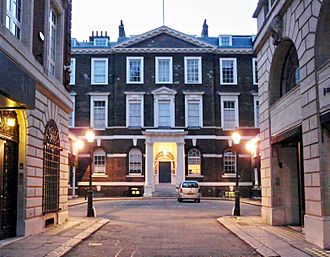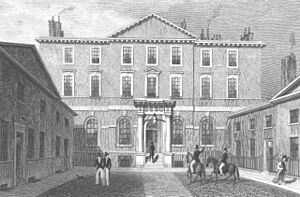Albany (London) facts for kids
Quick facts for kids Albany |
|
|---|---|

Albany at dusk (May 2014)
|
|
| Former names | Melbourne House |
| Alternative names | Albany |
| Etymology | Prince Frederick, Duke of York and Albany |
| General information | |
| Type | Residential apartment block |
| Location | Piccadilly, London |
| Country | United Kingdom |
| Coordinates | 51°30′32″N 0°8′19″W / 51.50889°N 0.13861°W |
| Current tenants | Various |
| Construction started | 1771 |
| Completed | 1776 |
| Owner | Peterhouse, Cambridge, Various |
| Design and construction | |
| Architect | Sir William Chambers Henry Holland |
| Listed Building – Grade I | |
Albany is a famous apartment complex in Piccadilly, London. It started as a large, fancy house in the 1770s. In 1802, it was changed into many separate apartments. These apartments are often called "sets."
Contents
Exploring Albany's History
How Albany Was Built
Albany was built between 1771 and 1776. Sir William Chambers was the architect. He designed it for the first Viscount Melbourne. The Viscount bought the land and an older house for £16,500. The new house, called Melbourne House, cost at least £50,000 to build.
It was a three-story mansion with seven wide windows. It also had two smaller buildings on the sides. These buildings created a front courtyard.
From Grand House to Apartments
In 1791, Lord Melbourne had many debts. He traded Melbourne House for a smaller one. He swapped with Prince Frederick, Duke of York and Albany. The Prince needed a bigger place for parties. The sale price was £23,571.
In 1802, the Duke also moved out. The house was then changed into 69 apartments. These were originally for single men. Henry Holland did this work. He divided the main house and its side buildings. He also added two new long buildings in the garden. These new parts were called The Ropewalk. They had a covered walkway with iron columns. Most apartments are reached by shared staircases. They feel a bit like college dorms.
Life at Albany Through Time
Famous People Who Lived Here
Since it became apartments, Albany has been a very fancy place to live. Many important people have called it home. These include the famous poet Lord Byron. Even a future Prime Minister, William Ewart Gladstone, lived here. Many members of the rich and powerful also lived at Albany.
Albany During World War II
During the Second World War, London was bombed. One of Albany's buildings was badly damaged by a German bomb. But after the war, it was rebuilt. It was made to look exactly like the original.
The Albany Trust Connection
The Albany Trust is a charity named after this building. Its first meetings were held here in the late 1950s. The founders, Jacquetta Hawkes and J. B. Priestley, lived at Albany.
Who Can Live at Albany Now?
Today, residents no longer have to be single men. However, there is a special rule. Children under the age of 14 are not allowed to live there.
Owning and Managing Albany
How Apartments Are Owned
The apartments, or "sets," are owned individually. This is called a "flying freehold." The owners are known as "Proprietors." In 2007, one apartment was for sale. Its price was about £2 million.
Peterhouse College's Role
About half of the apartments were owned by Peterhouse. This is a college at the University of Cambridge. A man named William Stone bought them during World War II. He was a former student of Peterhouse. He lived at Albany his whole life. He gave 37 apartments to the college when he died. He also gave other gifts.
How Albany Is Managed
A group of trustees manages Albany. They work for the apartment owners. The yearly rent for an apartment can be as much as £50,000. People who want to rent an apartment must be approved. A special committee checks them first. Only recently have women been allowed to apply to live there.
What's in a Name?
People have used both "Albany" and "the Albany." Rules from 1804 said it should be called "Albany." Both names were used in the 1800s and 1900s. In 1958, a newspaper called The Times wrote about it. They said knowing which name to use was a "snobbish test." If one name was common, people would use the other. In 1907, a writer said "the Albany" was common then. But the first residents just called it "Albany."
Albany in Books and Movies
Albany has appeared in many stories.
- In 1847, The Bachelor of the Albany was a novel about the building.
- In Benjamin Disraeli’s novel Sybil (1845), Charles Egremont lives there.
- In Dorothy Sayers' novel Clouds of Witness (1926), a character named Dennis Cathcart has a room in Albany.
- Mr. Fascination Fledgeby in Charles Dickens' Our Mutual Friend (1865) lives at Albany.
- In Oscar Wilde's The Picture of Dorian Gray (1890), Lord Fermor lives there.
- In Wilde's play, The Importance of Being Earnest (1895), John Worthing has an apartment at Albany.
- A. J. Raffles, a gentleman burglar, lived at Albany. He appeared in stories from 1898.
- Lord John Roxton from Arthur Conan Doyle's The Lost World (1912) also lived there.
- In P. G. Wodehouse's story "Uncle Fred Flits By" (1935), Pongo Twistleton lives at Albany.
- In the film Kind Hearts and Coronets (1949), Louis Mazzini moves into Albany.
- In Ian Fleming's James Bond novel Moonraker (1955), Max Meyer lives in Albany.
- In Graham Greene’s The Human Factor (1978), Dr. Percival lives at D.6.
- In Julian Fellowes' novel Belgravia (2016), Mr. John Bellasis lives in an apartment at Albany.
Notable Residents
Many interesting people have lived at Albany over the years. Some stayed for a short time when they were young.
- Antony Armstrong-Jones, a photographer.
- Sir Thomas Beecham, a famous conductor.
- Isaiah Berlin, a philosopher.
- Lord Byron, a well-known poet.
- George Canning, a politician.
- Bruce Chatwin, a writer.
- Alan Clark, a historian and politician.
- Sir Kenneth Clark, an art historian.
- Dame Edith Evans, an actress.
- William Ewart Gladstone, who became Prime Minister.
- Norman Foster, a famous architect.
- Edward Heath, who also became Prime Minister.
- Georgette Heyer, a writer.
- Aldous Huxley, a writer.
- Bill Nighy, an actor.
- J.B. Priestley, a writer.
- Jacob Rees-Mogg, a politician.
- Sebastian Shaw, an actor.
- Terence Stamp, an actor.
- William Henry Fox Talbot, a pioneer in photography.
- Herbert Beerbohm Tree, an actor.


